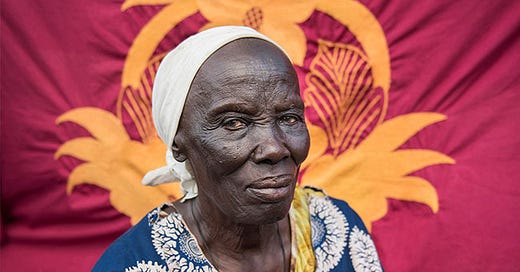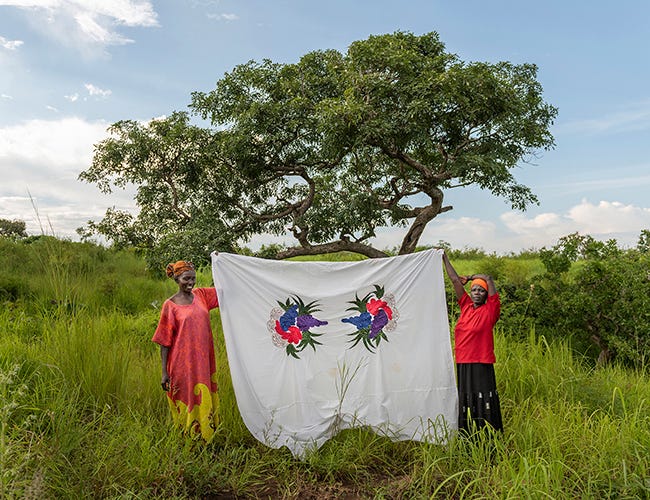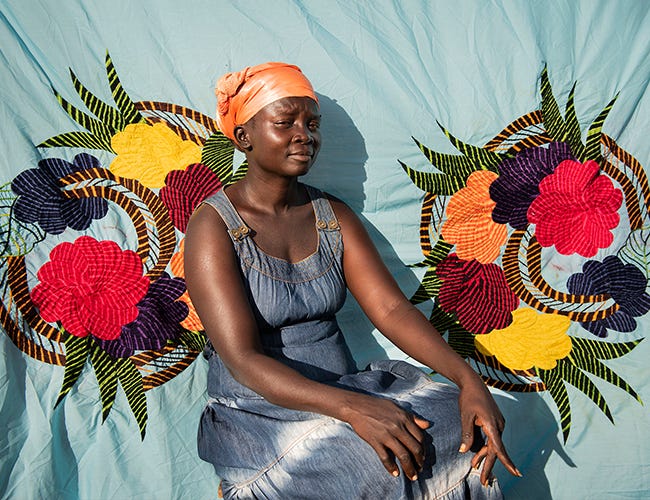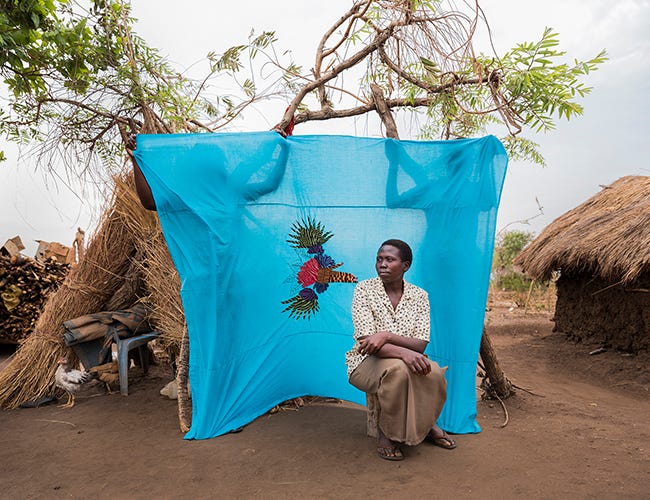In a world with such escalating destruction, it’s difficult to fully grasp the full cost of all the violence. Whether it is at the hands of armed forces targeting at our neighbors, or nature’s response to climatic upheaval, the impact is felt wherever we call home. There is a distinct feeling of it all being a singular human response to greed, a greed which is feral and unhinged.
Shock-horror: It doesn’t have to be like this. While it may seem completely overwhelming to act alone (no one is asking us to do that by the way) our time might be better spent joining forces, there is no shortage of charities (aka donation-based communities) to engage with. Charity Navigator can help you find the right one for you, whether you’re more able to donate time, services, or money.
Second to the human life costs I often wonder what else is lost underneath the literal and metaphorical rubble. The culture around textiles, unsurprisingly, is often the first to go. Its inherent fragility leaves itself in tatters on the floors of deserted streets and villages whether they be in Palestine, Palm Springs, Myanmar, Missouri, Ukraine, Kentucky, Lebanon, Ethiopia, sadly the list goes on.
There is a beautiful word in the Irish language that speaks to collective work, community spirit, a coming together of people for the greater good - meitheal. It’s more commonly used for harvest time or big repair jobs when neighbors gather together and complete the work as a team with the expectation that when your turn comes the same group would reassemble to ensure that the task gets completed as efficiently and quickly as possible.
South Sudan, which has endured decades of conflict, displacement, and environmental upheaval, has its own example of how to foment collective healing. Art and the communities around it have emerged not only as a form of expression but as a vital thread in the fabric of survival, identity, and collective repair. Once again I am reminded of the expression I heard many years ago as a student (but can no longer remember who it should be attributed to) “conflict breeds art”.
The Likikiri Collective, based in Juba, and the Milaya Project, based out of Bidibidi Refugee Settlement, Africa’s largest refugee camp and the second largest in the world, stand at the core of this cultural resilience. By the way, I hate the word resilience, but it is the best word to describe how we have to react when we can no longer be soft and welcoming, when we need to be tough and return to a fixed and more defensive state.
Named after the Bari word for “stories,” Likikiri draws from a deep oral tradition in which storytelling transmits social knowledge, cultural values, and historical memory across generations. Bari is a Nilotic language (as in the Nile River or region of Africa). Through embroidery, song, carpentry, beading, and more, South Sudanese artists continue this legacy, underscoring that culture is not a luxury, but a lifeline.
The Milaya Project is a non-profit organization founded by Swedish-German photographer Nora Lorek and National Geographic writer Nina Strochlic. Its mission is to support the traditional South Sudanese art of milaya (bedsheet) embroidery by connecting refugee women with customers around the world. In Uganda’s Bidibidi refugee settlement, South Sudanese businesswomen Rose Asha and Rose Jaun lead collectives of hundreds of women who create these embroidered textiles. All profits from the Milaya Project go directly toward helping these women scale their businesses and sustain their craft.
In this context, where entire communities are uprooted by war and/or natural disasters, embroidery and other tactile arts become much more than aesthetic practice; they are acts of reclamation and resistance. Likikiri’s community-based work fosters this spirit through story circles—gatherings where artists of all kinds reflect on their lives and share their struggles, joys, and hopes. These gatherings create safe, generative spaces where embroidery is not only a form of craft but also a way of thinking, healing, and imagining. Here, women exchange not just stitches and designs, but advice, emotional support, and resilience strategies. Similarly, when men artisans speak of their fears—of lost traditions, of youth uninterested in woodwork—they also share what motivates them: their partners, their children, their sense of worth anchored in the ability to make and mend. They carry stories of survival, beauty imagined in defiance of violence, and the economic resourcefulness that helps families eat.
“We've conducted story circles with groups of different types of artists. So one particular story circle we conducted with women who embroider bed sheets, the embroidery of bedsheets is a really well known and important tradition amongst women in South Sudan. And these bed sheets are incredibly beautiful, but they also fetch a high price. So they are often given as gifts at marriage. So women not only are telling really elaborate and intricate stories of their lives through their art, but the sheets themselves then have really been a survival mechanism in terms of ensuring that women are literally able to feed their families. So the stories that came out of that particular circle were really powerful in terms of understanding exactly what this art meant to the women involved. But also you could see that the art itself was a way of escaping the ugliness of war. And some of the women literally said, you know, we close our eyes and we dream of something beautiful that we can embroider as a way of not having to constantly focus on the reminders of war that's everywhere. So we don't-- we don't embroider that tree that's burnt down because that's not beautiful. Instead, we imagine a beautiful flower and colours are able to bring us some peace.”4
This commitment to cultural continuity is central to Likikiri’s mission: to use the arts and humanities to reflect everyday realities and elevate marginalized voices. Through collaboration across disciplines and communities, their work demonstrates that the imagination is a powerful tool in both development and peacebuilding. As climate shocks, poverty, and systemic violence continue to challenge the region, the Likikiri model reminds us that community-rooted creative practices are essential not just to coping—but to envisioning new futures.
By preserving and reactivating traditions like embroidery within a framework of shared storytelling and social connection, the Likikiri Collective is helping to stitch together the past, present, and the possibility of South Sudan - one thread, one story, one gathering at a time.
At a much smaller scale each of us to different degrees are dealing with our own crises. Health issues, family drama, work drama, financial burdens, emotional stressors. Social groups, aka communities can help us navigate these too, maybe not by offering solutions but distraction and a feeling of being supported so we can come to the answer ourselves. Whatever “advice” we might share, no matter how accurate or on-point it is it won’t be “received” unless it is at the right “frequency” and ultimately if the sound waves reach the intended “destination”. The heavy use on quotation marks reflects my own uncertainty on whether there is more value in speaking rather than listening.
Just sitting together and embroidering is a really important form of social and cultural capital because women are talking and sharing problems. But also are using that space to problem solve and to help each other find the strength and resilience to keep… to keep going in a context that's really, really challenging. 6
I invite you to join our next sewcial experiment on May 25th at 10:00 AM ET. Bring whatever you’re working on or planning to work on and join your own little story circle!
In the meantime, some music!
Le grá,
Catherine x-x-x-x-x-x-x-x
Photograph by Liz Calka for The Milaya Project
ibid
ibid
Professor Tasmin Bradley, Professor of International Development Studies, Portsmouth, England. In conversation with Anna Rose on Life Solved podcast (Ep. 23) 16th February 2021
Photograph by Liz Calka for The Milaya Project
Professor Tasmin Bradley, Professor of International Development Studies, Portsmouth, England. In conversation with Anna Rose on Life Solved podcast (Ep. 23) 16th February 2021







